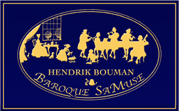Playing the harpsichord is a sensuous affair; the sound you create is intrinsically connected to a tactile experience. On my very first harpsichord, an Italian made by Rainer Schütze, Heidelberg, I felt the actual vibration of the strings in the keys. I learned to sing through my fingers using a single eight foot stop, and with the two eight foot registers, which required more strength from the fingers, I ventured into grander sonorities. I discovered how the inter-weavings of trills and arpeggios, which could obscure the precise beat of the metrical structure, make for a subtle and exciting rhythmical whirl in a music which appeared otherwise rather plain on paper. Taking rhythmical liberties within the bar, or even within metrical units, while keeping time became an exhilarating challenge. And articulation, the equivalent of enunciation in speech, became almost a goal in itself. By varying the actual sound duration of each given note without disturbing the prescribed rhythmic flow of the notation, in other words, by shortening or lengthening their written value one adds a whole new dimension; the music begins to speak. The fingers can obtain in this way effects that the sustain pedal on a piano can only do in an indiscriminate fashion. Judiciously applying minute silences in between the notes of one voice can make another voice more prominent and helps to bring clarity to a polyphonic texture. It may seem contradictory to be plastic and rigid at the same time, but instead, these subtle irregularities and varieties in sound density serve to convey a sense of direction in between the metrical pillars of the music and to highlight specific melodic or harmonic events. What could sound flat and dry without these artifices becomes dynamic and colourful instead, the music comes to life and receives as it were, an extra dimension. Harpsichord technique is less about virtuosity per se than about mastery of style and idiom. Thus, gradually the basis was laid for my approach to basso continuo, which rest precisely on a constantly varying sound density and that balancing act between rhythmical plasticity and a solidly held metrical structure and tactus in support of the ensemble.
Not just by playing repertoire but by regular experimentation and improvisation, did my playing become versatile and my hearing more acute. Some of my experiments during student days were intended to enhance the link between tactility and sound, including those in which the fingers, the hearing or the sight were purposely limited. Coming out of the cold in winter I played music or scales or exercises with icy fingers until they began to tingle and the blood would start rushing through them. I played with the lid completely closed so that I could not see the movements of my fingers and hands and the sound was muffled; or I practiced while a vacuum cleaner was running, so that I could only feel what I was playing. When one practices without hearing oneself playing, the inflections of a cadence or a trill or a port-de-voix still keep anchored in their physical movement, which proves that a perfect and graceful sound is based on a perfect and graceful gesture. Playing with the lid closed on a two-manual harpsichord has the added advantage of making the fingers find their way over the keyboard without any visual help. One can practice in this manner not only from a printed score but also by spending many hours improvising, all the while appreciating even the reduced, muffled sound output.
These hurdle exercises makes for a certain detachment between the mental and physical aspect of playing which I felt necessary for developing digital autonomy. In this way the fingers themselves grow capable of carrying through in unexpected circumstances which would be less than ideal. I had indeed a few of such events in concert while playing continuo, once in an extremely noisy environment in Amsterdam with clattering dishes in the background, another time in Calcutta, India where we as ensemble continued to play blindly the complex trio sonata from Bach’s Musical Offering during a sudden black-out, and once (much to my consternation and that of my colleagues) in Austin, USA, where I kept providing uninterrupted basso continuo harmonies in the right hand while trying to reposition my score, after it had slid down after an awkward page turn, first onto the keyboard, then onto my lap and down onto the floor.
My exercises were above all intended to fully acquaint myself from a tactile perspective with Baroque idiom so as to render them natural and meaningfully, all the while weaving in those characteristic musical figures and formulas, ornaments and cadences. Indeed tactile-acoustical exercises serve the purpose of appropriating a language. By imprinting them into the consciousness of one's mind and fingers one makes these musical figures come alive. Just as many manners of etiquette and protocol accompanied social life in the baroque period, these musical figures are part and parcel of the composition and bring a natural grace to every phrase, even where the precise historical significance may have become obscure and obsolete.
The fact that our modern world is increasingly devoid of etiquette, ritual, protocol and formality is not a reason for us to deny their significance and raison-d’être in another time frame or culture. It is only ignorance and arrogance to consider baroque flourishes in music as empty and mechanical, justifying that therefore they can be performed void of meaning.
Articulation plays a major role in the expression of Western music of the 17th and 18th Century and is not to be conceived of as a mechanical application of bow strokes, tonguing or clever interchanges between finger






